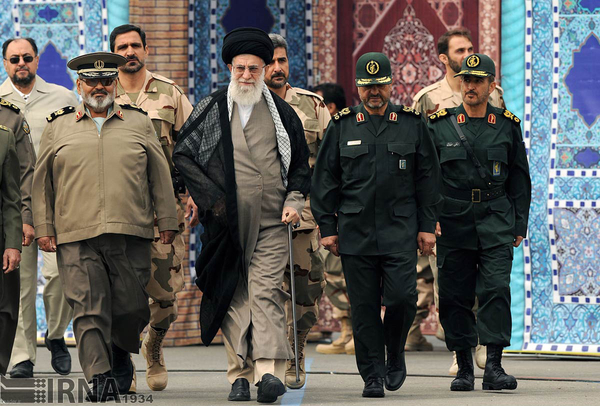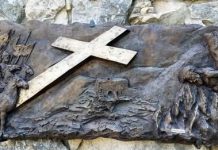The Ayatollah’s Plan for Israel and Palestine
Amir Taheri/Gatestone Institute/July 31, 2015
The book has received approval from Khamenei’s office and is thus the most authoritative document regarding his position on the issue. Khamenei makes his position clear from the start: Israel has no right to exist as a state He claims his strategy for the destruction of Israel is not based on anti-Semitism, which he describes as a European phenomenon. His position is based on “well-established Islamic principles.”
According to Khamenei, Israel, which he labels an “enemy” and “foe,” is a special case for three reasons. The first is that it is a loyal “ally of the American Great Satan” and a key element in its “evil scheme” to dominate “the heartland of the Ummah.”
Khamenei describes Israel as “a cancerous tumor” whose elimination would mean that “the West’s hegemony and threats will be discredited” in the Middle East. In its place, he boasts,” the hegemony of Iran will be promoted.”
Khamenei’s tears for “the sufferings of Palestinian Muslims” are also unconvincing. To start with, not all Palestinians are Muslims. And, if it were only Muslim sufferers who deserved sympathy, why doesn’t he beat his chest about the Burmese Rohingya and the Chechens massacred and enchained by Vladimir Putin, not to mention Muslims daily killed by fellow-Muslims across the globe?
In the early days of his mission, the Prophet Muhammad toyed with the idea of making Jerusalem the focal point of prayers for Islam. He soon abandoned the idea and adopted his hometown of Mecca. For that reason, some classical Muslim writers refer to Jerusalem as “the discarded one,” like a first wife who is replaced by a new favorite. In the 11th century the Shiite Fatimid Caliph, Al-Hakim even ordered the destruction of Jerusalem.
Dozens of maps circulate in the Muslim world, showing the extent of Muslim territories lost to the infidel that must be recovered. These include large parts of Russia and Europe, almost a third of China, the whole of India and parts of the Philippines and Thailand.
“The flagbearer of Jihad to liberate Jerusalem.”This is how the blurb of “Palestine,” a new book, published by Islamic Revolution Editions last week in Tehran, identifies the author. The author is “Grand Ayatollah Seyyed Ali Husseini Khamenei,” the “Supreme Guide” of the Islamic Republic in Iran, a man whose fatwa has been recognized by U.S. President Barack Obama as having the force of law.
Edited by Saeed Solh-Mirzai, the 416-page book has received approval from Khamenei’s office and is thus the most authoritative document regarding his position on the issue. Khamenei makes his position clear from the start: Israel has no right to exist as a state.
He uses three words. One is “nabudi” which means “annihilation”. The other is “imha” which means “fading out,” and, finally, there is “zaval” meaning “effacement.”
Khamenei claims that his strategy for the destruction of Israel is not based on anti-Semitism, which he describes as a European phenomenon. His position is based on “well-established Islamic principles”, he claims. One such is that a land that falls under Muslim rule, even briefly, can never again be ceded to non-Muslims. What matters in Islam is control of a land’s government, even if the majority of inhabitants are non-Muslims. Khomeinists are not alone in this belief.
Dozens of maps circulate in the Muslim world, showing the extent of Muslim territories lost to the infidel that must be recovered. These include large parts of Russia and Europe, almost a third of China, the whole of India and parts of the Philippines and Thailand.
However, according to Khamenei, Israel, which he labels as “adou” and “doshman,” meaning “enemy” and “foe,” is a special case for three reasons. The first is that it is a loyal “ally of the American Great Satan” and a key element in its “evil scheme” to dominate “the heartland of the Ummah.”
The second reason is that Israel has waged war on Muslims on a number of occasions, thus becoming a “hostile infidel” (“kaffir al-harbi”). Finally, Israel is a special case because it occupies Jerusalem, which Khamenei describes as “Islam’s third Holy City.” He intimates that one of his “most cherished wishes” is to one day pray in Jerusalem.
Khamenei insist that he is not recommending “classical wars” to wipe Israel off the map. Nor does he want to “massacre the Jews.” What he recommends is a long period of low-intensity warfare designed to make life unpleasant if not impossible for a majority of Israeli Jews so that they leave the country.
His calculation is based on the assumption that large numbers of Israelis have dual-nationality and would prefer emigration to the United States or Europe to daily threats of death. Khamenei makes no reference to Iran’s nuclear program. But the subtext is that a nuclear-armed Iran would make Israel think twice before trying to counter Khamenei’s strategy by taking military action against the Islamic Republic.
In Khamenei’s analysis, once the cost of staying in Israel has become too high for many Jews, Western powers, notably the U.S., which has supported the Jewish state for decades, might decide that the cost of doing so is higher than possible benefits. Thanks to President Obama, the U.S. has already distanced itself from Israel to a degree unimaginable a decade ago.
Khamenei counts on what he sees as “Israel fatigue.” The international community would start looking for what he calls “a practical and logical mechanism” to end the old conflict. Khamenei’s “practical and logical mechanism” excludes the two-state formula in any form. “The solution is a one-state formula,” he declares. That state, to be called Palestine, would be under Muslim rule but would allow non-Muslims, including some Israeli Jews who could prove “genuine roots” in the region, to stay as “protected minorities.”
Under Khamenei’s scheme, Israel plus the West Bank and Gaza would revert to the United Nations’ mandate for a brief period during which a referendum would be held to create the new state of Palestine. All Palestinians and their descendants, wherever they are, would be able to vote, while Jews “who have come from other places” would be excluded.
Khamenei does not mention any figures for possible voters in his dream referendum. But studies by the Foreign Ministry in Tehran suggest that at least eight million Palestinians across the globe would be able to vote, against 2.2 million Jews “acceptable” as future second-class citizens of the new Palestine. Thus, the “Supreme Guide” is certain of the results of his proposed referendum.
He does not make clear whether the Kingdom of Jordan, which is located in 80 percent of historic Palestine, would be included in his one-state scheme. However, a majority of Jordanians, who are of Palestinian extraction, would be able to vote in the referendum and, logically, become citizens of the new Palestine.
Khamenei boasts about the success of his plans to make life impossible for Israelis through terror attacks from Lebanon and Gaza. His latest scheme is to recruit “fighters” in the West Bank to set-up Hezbollah-style units. “We have intervened in anti-Israel matters, and it brought victory in the 33-day war by Hezbollah against Israel in 2006 and in the 22-day war between Hamas and Israel in the Gaza Strip,” he boasts.
Khamenei describes Israel as “a cancerous tumor” whose elimination would mean that “the West’s hegemony and threats will be discredited” in the Middle East. In its place, he boasts, “the hegemony of Iran will be promoted.” Khamenei’s book also deals with the Holocaust, which he regards either as “a propaganda ploy” or a disputed claim. “If there was such a thing,” he writes, “we don’t know why it happened and how.”
Khamenei has been in contact with professional Holocaust deniers since the 1990s. In 2000, he invited Swiss Holocaust-denier Jürgen Graf to Tehran and received him in private audiences. French Holocaust-denier Roger Garaudy, a Stalinist who converted to Islam, was also feted in Tehran as “Europe’s’ greatest living philosopher.”
It was with Khamenei’s support that former President Mahmoud Ahmadinejad set up a “Holocaust-research center” led by Muhammad-Ali Ramin, an Iranian functionary with links to German neo-Nazis who also organized annual “End of Israel” seminars. Despite efforts to disguise his hatred of Israel in Islamic terms, the book makes it clear that Khamenei is more influenced by Western-style anti-Semitism than by classical Islam’s checkered relations with Jews.
His argument about territories becoming “irrevocably Islamic” does not wash, if only because of its inconsistency. He has nothing to say about vast chunks of former Islamic territory, including some that belonged to Iran for millennia, now under Russian rule. Nor is he ready to embark on Jihad to drive the Chinese out of Xinjiang, a Muslim khanate until the late 1940s. Israel, which in terms of territory accounts for one per cent of Saudi Arabia, is a very small fry.
Khamenei’s shedding of tears for “the sufferings of Palestinian Muslims” are also unconvincing. To start with, not all Palestinians are Muslims. And, if it were only Muslim sufferers who deserved sympathy, why doesn’t the “Supreme Guide” beat his chest about the Burmese Rohingya and the Chechens massacred and enchained by Vladimir Putin, not to mention Muslims daily killed by fellow-Muslims across the globe?
At no point in these 416 pages does Khamenei even mention the need to take into account the views of either Israelis or Palestinians regarding his miracle recipe. What if Palestinians and Israelis wanted a two-state solution?
What if they chose to sort out their problems through negotiation and compromise rather than the “wiping-off-the-map” scheme of he proposes? Khamenei reveals his ignorance of Islamic traditions when he designates Jerusalem as “our holy city.” As a student of Islamic theology, he should know that “holy city” and “holy land” are Christian concepts that have no place in Islam.
In Islam, the adjective “holy” is reserved only for Allah and cannot apply to anything or anyone else. The Koran itself is labeled “al-Majid” (Glorious) and is not a holy book as is the Bible for the Christians. The “Supreme Guide” should know that Mecca is designated as “al-Mukarramah” (the Generous) and Medina as “al-Munawwarah” (the Enlightened). Even the Shi’ite shrine cities of Iraq are not labeled “muqqaddas” (holy). Najaf is designated as “al-Ashraf” (the Most Noble) and Karbala as “al-Mualla” (the Sublime).
In the early days of his mission, the Prophet Muhammad toyed with the idea of making Jerusalem the focal point of prayers for Islam. He soon abandoned the idea and adopted his hometown of Mecca, where the black cube (kaabah) had been a magnet for pilgrims for centuries before Islam. For that reason, some classical Muslim writers refer to Jerusalem as “the discarded one” (al-yarmiyah) like a first wife who is replaced by a new favorite. In the 11th century, the Shiite Fatimid Caliph, Al-Hakim, even ordered the destruction of “discarded” Jerusalem.
The Israel-Palestine issue is not a religious one. It is a political conflict about territory, borders, sharing of water resources and security. Those who, like Khamenei, try to inject a dose of religious enmity into this already complex cocktail deserve little sympathy.
http://www.gatestoneinstitute.org/6263/khamenei-israel-palestine






















